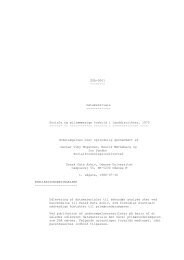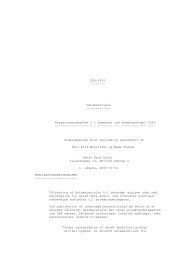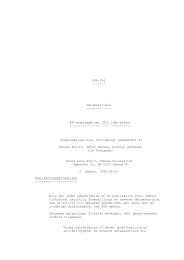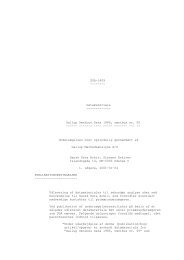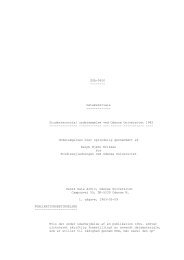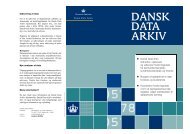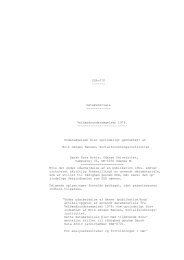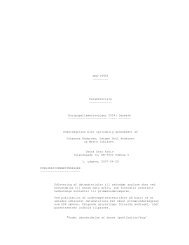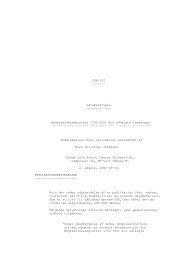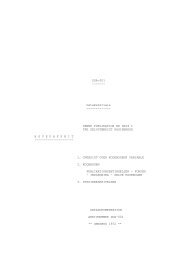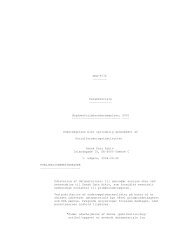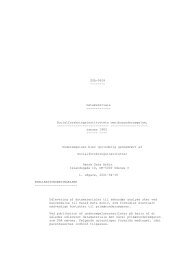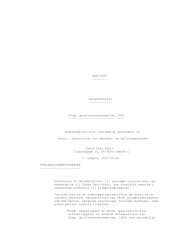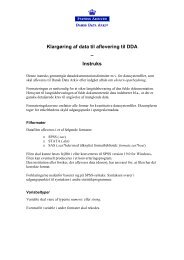Metode og Data nr. 86 - DDA Samfund - Dansk Data Arkiv
Metode og Data nr. 86 - DDA Samfund - Dansk Data Arkiv
Metode og Data nr. 86 - DDA Samfund - Dansk Data Arkiv
Create successful ePaper yourself
Turn your PDF publications into a flip-book with our unique Google optimized e-Paper software.
The descriptive survey which is mentioned<br />
here has, as planned, formed the basis of a follow-up<br />
survey for which the data collection<br />
took place in the period 1 November, 1990 to<br />
25 May, 1991. (This data material comprises<br />
270 health variables for 202 respondents).<br />
The survey forms part of a European survey<br />
of dietary habits, life style and health of the<br />
elderly under the Epidemiol<strong>og</strong>y Committee of<br />
the EC’s Medical Research Council<br />
(COMAC/EPID).<br />
The purpose of this survey is to examine<br />
dietary habits and health of 70 to 75-year-old<br />
men and women. 435 men and women born<br />
between 1 January, 1913 and 31 December,<br />
1918 and living in the municipality of<br />
Roskilde were selected at random and were<br />
invited to participate in a survey on dietary<br />
habits and health. A total of 202 persons<br />
participated in the survey.<br />
The interviewing took place at three visits<br />
in the participants’ homes. During the first<br />
visit an interview was carried out about social<br />
conditions, life style and health. The participants<br />
were asked to and informed about how<br />
to carry out a 3-day food record (two<br />
weekdays and one weekend day). At the<br />
second visit the participants were asked about<br />
their usual dietary habits. The most common<br />
food items and/or dishes (e.g. a slice of bread<br />
with and without butter) were measured and<br />
weighed on a calibrated digital weight in the<br />
participant’s kitchen. In addition, height and<br />
weight were measured and a blood sample<br />
was taken.<br />
The ability of the dietary interviews as<br />
regards examining the dietary habits was<br />
analysed and found satisfactory when the<br />
results of the interviews were compared with<br />
the descriptions of the diet records.<br />
All dietary data were coded and converted<br />
into energy and nutrients by means of the<br />
computer pr<strong>og</strong>ram Dankost.<br />
The survey forms part of an EC-project<br />
entitled „EuroNut: SENECA-study“.<br />
File dimensions: 202 cases, 316 variables.<br />
<strong>DDA</strong>-1616 „Gene Technol<strong>og</strong>y,<br />
1989“<br />
(Ole Borre)<br />
This survey deals with people’s knowledge of<br />
and attitude to new technol<strong>og</strong>y and science in<br />
side 55 <strong>Metode</strong> & <strong>Data</strong> <strong>nr</strong>. <strong>86</strong> – 2002<br />
general and to genetic engineering in<br />
particular.<br />
Some of the questions dealing with new<br />
technol<strong>og</strong>y and science in general (which are<br />
to map out general interest in and attitude to<br />
the subject) were translated from interview<br />
surveys carried out in the United States.<br />
Another group of questions deal specifically<br />
with genetic engineering, i.e. artificial<br />
coupling of genes from different individuals.<br />
The purpose of these questions is to map<br />
out:<br />
• The respondent’s attitude to genetic engineering<br />
in specific contexts.<br />
• The respondent’s general attitude.<br />
• The respondent’s attitude to the debate on<br />
genetic engineering.<br />
• The respondent’s interest in the debate.<br />
• The respondent’s confidence in various<br />
groups of persons taking part in the<br />
debate.<br />
• The respondent’s actual knowledge of various<br />
aspects of genetic engineering.<br />
Finally, a number of questions are asked<br />
about the respondent’s attitudes to and interest<br />
in politics. This is done because previous<br />
research has shown that grouping according<br />
to these political criteria is essential in<br />
connection with analyses of attitudes to<br />
technol<strong>og</strong>y and science.<br />
The survey, which was carried out in<br />
connection with the Danish Omnibus Survey,<br />
April 1989 (<strong>DDA</strong>-1479), is the second part of<br />
a major project entitled „Genteknol<strong>og</strong>i:<br />
innovation <strong>og</strong> social bevægelse“ (Gene<br />
Technol<strong>og</strong>y: Innovation and Social<br />
Movement). The first phase, which examines<br />
the development of attitudes to gene<br />
technol<strong>og</strong>y in the period 1987-88, is based on<br />
three surveys carried out by the AIM Institute<br />
in September 1987, February 1988, and May<br />
1988. (The first and the last of these surveys<br />
form part of a more comprehensive electorate<br />
panel study carried out in connection with two<br />
general elections, <strong>DDA</strong>-1480: Danish<br />
Electorate Studies, September 1987 and May<br />
1988).<br />
File dimensions: 1512 cases, 73 variables.




